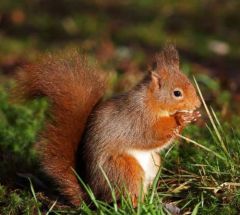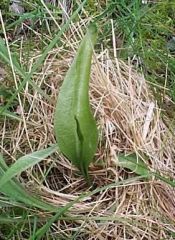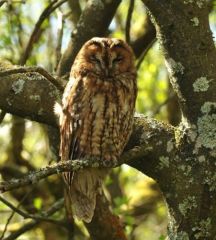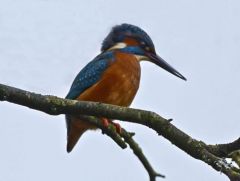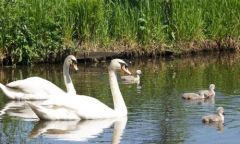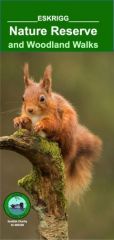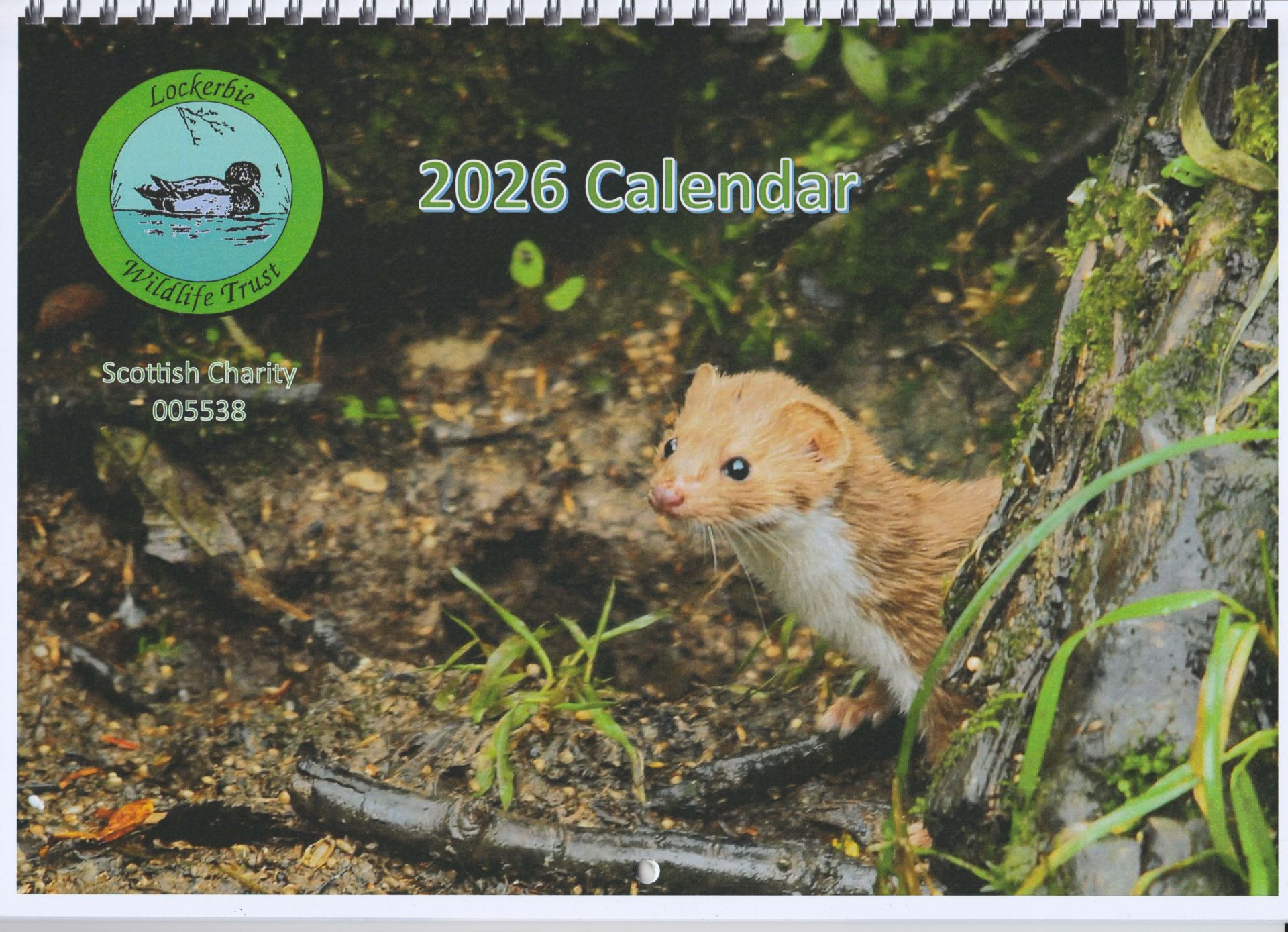
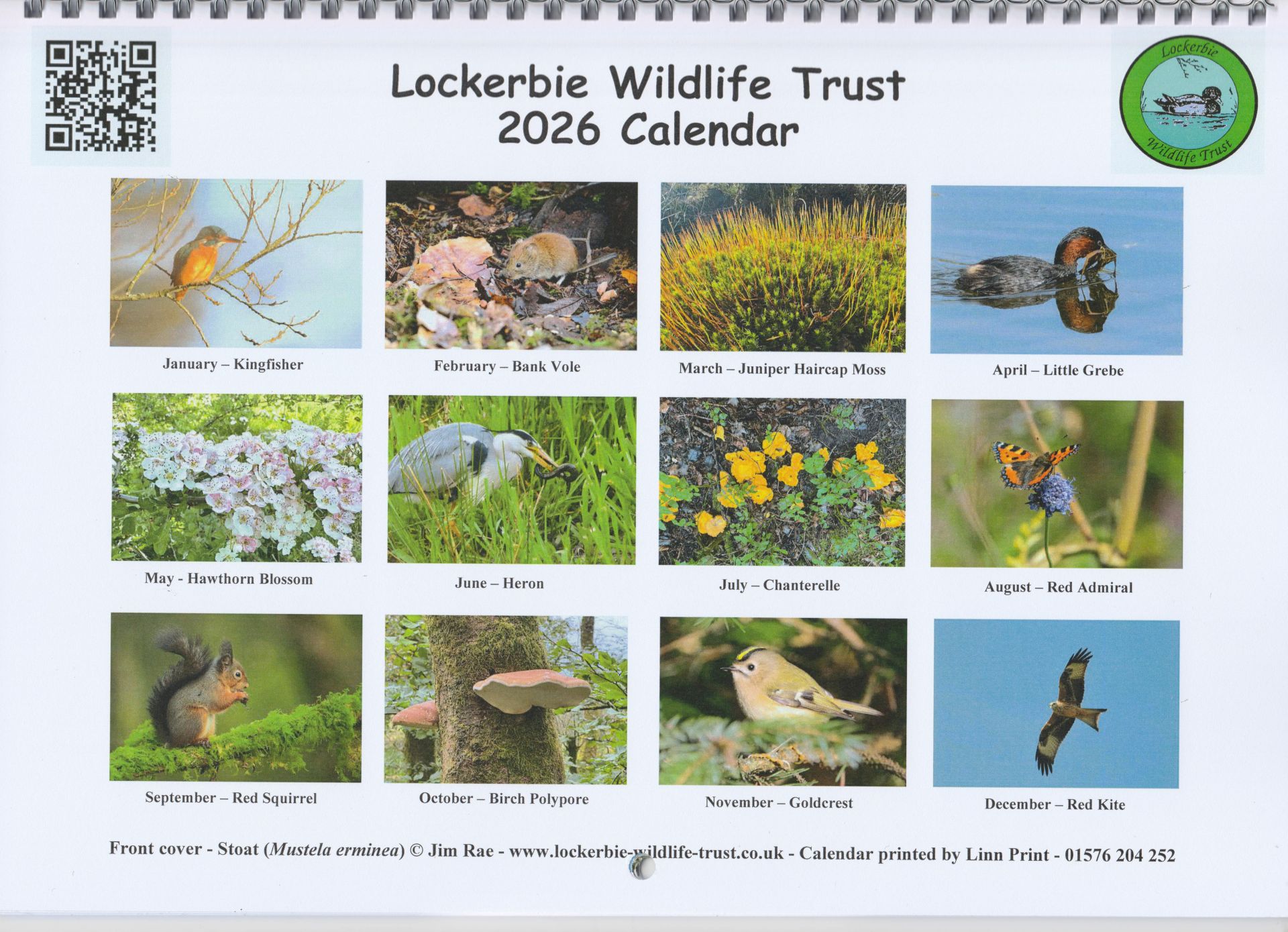
LWT 2026 Calendar now for sale
They are £12.50 (+ p&p if applicable) each and can be delivered in the Lockerbie Area by arrangement
Available at the Post Office
Payment by cash or by cheque made out to Lockerbie Wildlife Trust
To order your copy today please contact Jim Rae
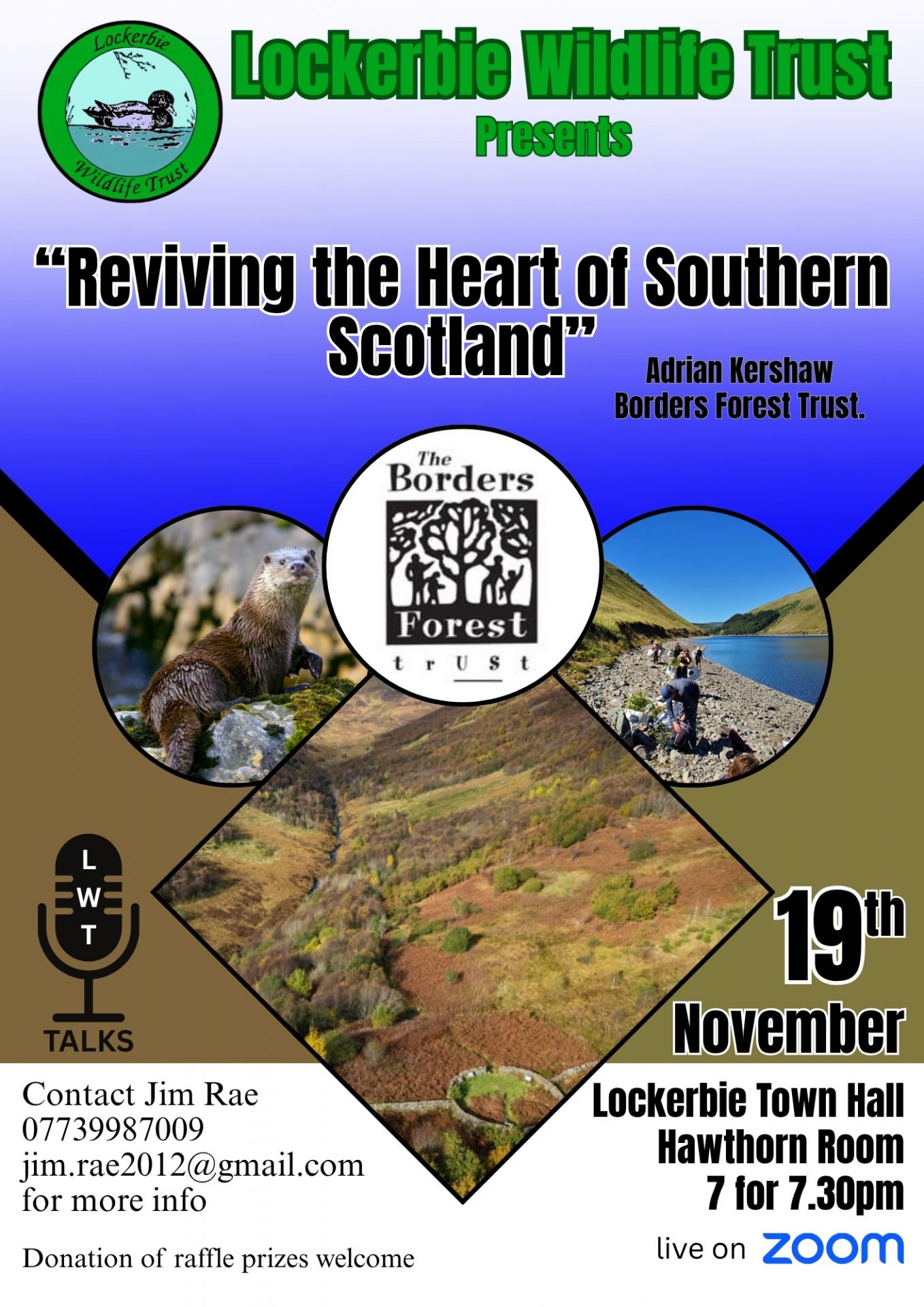
Click to enlarge!
Lockerbie Wildlife Trust and Eskrigg Nature Reserve
Lockerbie Wildlife Trust manages Eskrigg Nature Reserve and Woodland Walks and runs an annual programme of talks, visits and workshops relating to wildlife and conservation for members, schools and other interested parties.
The reserve and the adjacent woodland walks offer visitors the opportunity to relax in peaceful surroundings and observe or photograph the resident fungi, flora and fauna. Some people may prefer to explore the range of habitats or be a bit more energetic and walk their dogs, jog or cycle round the woodland trails. One of the trails is a 3km hardcore circuit that allows disabled access to the woodlands.
The Reserve and Woodland Walks are open all year round. Why not come along and see for yourself or book in for any of the organised activities?
If you would like to support
Lockerbie Wildlife Trust
just click on the button below:
Star Species
Objects of the Trust
- To encourage wildlife conservation.
- To manage such conservation sites as the Trust accepts responsibility for.
- To promote the education and understanding of all age groups regarding local wildlife and its management.
- To encourage the use of Trust properties for educative recreation.
- To do all such other things as are incidental or conducive to the attainment of the above objects or any of them.
Lockerbie Wildlife Trust was established in September 1988 and was granted charitable status in November 1989.
Scottish Charity Number - SC005538
The History of Eskrigg Reserve
Introduction
The Eskrigg Reserve is on the site of an old curling pond, built around 1850. It occupies 7 acres (2.83 hectares) and contains a mixture of habitats including mixed woodland, grassland, heathland, willow carr, sedge bed, reed bed, stream and pond each with its own associated flora and fauna. There is coniferous woodland to the north and west with a rich deciduous understory, permanent grassland to the east and marshland to the south. Notable animal species over the years include Red Squirrel, Kingfisher, Little Grebe, Tawny Owl, Willow Tit and Woodcock. You will also find the rare Adder’s Tongue Fern there.
In the early 1980s
In the early 1980s, Jim Rae was Principal Teacher of Biology at Lockerbie Academy. He taught Biology, Science and a course he helped to develop called Natural Resources. In the latter course, pupils were given a practical introduction to Forestry, Fish Farming, Agriculture, Horticulture and Conservation. The course involved going out into the local community and doing practical work like planting and felling trees, rearing trout, assisting with the lambing, weighing pigs, growing plants in the greenhouse and garden, clearing and burning rhododendrons, clearing rubbish out of streams, clearing litter from the road sides and lay-bys. The tasks were many and varied. However, the conservation part of the course was very limited and the students had little or no opportunity to develop and follow up on their activities. Jim started looking for a site where the class could get some continuity and get involved with longer-term planning and management as well as learning practical skills.
1986 - 1989
Jim Rae learned of the old curling pond from a pupil in his Natural Resources class. After visiting the site with the class, he was impressed by the range of habitats in such a small area, but noticed that one of the habitats, a monoculture of reed-canary grass, covered more than three acres and supported a very limited fauna. The pond had been drained and the natural succession of vegetation over many years had eliminated all open water. Jim quickly realized that, by digging out much of the reed-grass and repairing the sluice gate, a pond could be re-established thereby increasing the biodiversity and, at the same time, creating a resource for the local community, including his Natural Resources class at the school.
He explained his ideas to Sir Rupert Buchanan-Jardine, owner of Castle Milk Estate, then applied for, and was granted in January 1987, a joint one-year lease of the curling pond site with the then shooting tenant Henry Strath.
Jim spent the following year seeking advice and assistance from many experts in the field of conservation. He arranged a survey of the area to determine future water levels. With the assistance of Mary Martin (Regional Plant Recorder) and Elizabeth Kungu (Bryophyte expert), he identified as many plants and animals as possible and drew up a potential management plan.
In August 1987, Jim started a Conservation Class at Lockerbie Academy and together they discussed and worked on the management plan and obtained estimates for digging out the pond. They also cleared the ruins of the old curling hut and a mass of rubbish that had accumulated over the years.
In September 1987, a public meeting was held at Lockerbie Academy at which Jim Rae explained the draft plans to interested members of the local community, including Sir Rupert Buchanan-Jardine and Sir Hector Monro, the local MP. Jim's plans received overwhelming approval and that evening a Local Support Group was set up. At the first meeting of the support group, in October 1987, the members decided to form the Lockerbie Wildlife Trust and to name the old curling pond site Eskrigg Reserve.
Members of Jim's conservation class organised a sponsored cycle relay, on the 6th of October 1987, round the Academy's feeder primary schools (101 miles) to raise the funds for digging out the pond.
Also in October, the Lockerbie-Johnstone Cub Pack, with their leaders and helpers, cleared 170 yards of ditches to ensure the pond had a good water supply when it was later dug out.
Jim Rae took on the sole lease of the pond site for a year in 1988 and, throughout the spring of that year, continued his research and, in discussion with members of the support group, determined the objects of the Lockerbie Wildlife Trust.
Also in the spring of 1988, the Lockerbie Scouts dug out two silt traps and cleared some more ditches. The Countryside Skills Group from the Barony College coppiced the willows along the sluice dyke, helped free the sluice gate and started a path behind the sluice dyke.
Then, in May 1988, a local firm - Dalgliesh Brothers from Moffat - dug out the pond area. Working on palettes, the digger was used to clear the pond area and create islands and banks. The sluice was repaired, an overflow pipe (donated by Express Cheese Factory) was installed and the pond area was flooded.
When asked for his bill for digging out the pond, Jim Dalgliesh said he thought the 'Pond Project' was a great idea and that he had had a good year, so he was not going to charge us. This was just one of the many generous donations and valuable support provided by the local community over the years.
Within a month there was good growth on the islands and a wide variety of wildlife in the pond. In the Summer of '88, eight weeks of dry weather resulted in the pond drying up. The pond filled up again in the autumn. This helped to determine the future management policy for the site. In June, pupils from Lockerbie Academy erected two bird-watching hides, each made from converted fibreglass roadman's huts donated by Dumfries and Galloway Council.
In September 1988, the inaugural meeting of the Lockerbie Wildlife Trust was held and a programme of talks, visits, workshops and fund-raising events was organised for the year ahead. Over the next year, Academy pupils, former pupils, Scouts, Cubs and students from the Barony College helped Trust members with clearing, construction and maintenance work. One major exercise was the construction of a boardwalk below the sluice dyke to the East Hide and this was done in sections over the next few years.
In January 1989, the lease for the pond site was transferred to Lockerbie Wildlife Trust for an initial term of ten years, subject to review after five. The pond site then became officially recognised as Eskrigg Reserve. Throughout '89 Jim Rae consulted widely and drafted a Constitution for the Trust. The Forest Manager for Castle Milk and Corrie Estates requested Jim's help in establishing woodland nature trails in South Turnmuir and Well Springs Plantations adjacent to the Reserve, in Birkshaw Forest and at Whitcastles north of Corrie. This he did and, with Sir Rupert's agreement, he also undertook to look after the Woodland Walks beside the Reserve but not at the other two sites.
In November 1989 the Lockerbie Wildlife Trust was granted charitable status:
Scottish Charity - SC 005538.
1990 - 2009
Jim continued to manage Eskrigg Reserve and Woodland Walks for the Lockerbie Wildlife Trust, during his spare time, over the next 20 years. He continued to receive a lot of support from the local community and members of the Trust.
Former pupils helped to erect a shelter on the site of the old curling hut, with timber donated by a local joiner, metalwork donated by the local blacksmith, bricks donated by a local builder and seats donated by a local farmer and a local insurance firm. All the Trust had to pay for was the felt and clout nails for the roof and preservative for treating the timber.
The path through the Reserve was initially a grass trail, but very soon had to be upgraded to a woodchip path after the local pony club rode through by mistake.
The Reserve and adjacent woodland is an ideal site for biological fieldwork. Jim organised many different wildlife workshops and events, during term time and holidays, particularly for local youngsters. A number of social events, including a wedding, woodland fair and a concert, were also held at the Reserve.
In 2001, the Lockerbie Wildlife Trust held the first of its Annual Nut Races. These races provide a Family Fun afternoon and also raised some funds to help pay for the Reserve maintenance.
During the 14 years, from 1988 to 2002, the Reserve pond was managed the way it used to be when it was a shooting and curling pond: it was drained in the late summer in order to take off a crop of coarse hay and then flooded again for the winter. However, the weather was so bad in the Autumn of 2002 that when the pond area was drained it did not dry up and the reeds and grasses could not be cut. The result was that there was no open water when the pond was filled up again. The pond management had to change. Agreement was reached with the Scottish Environment Protection Agency (SEPA) that, if necessary, the pond fringes could be sprayed each year to stop the grasses spreading into the pond area. However, the Trust decided to pull the invading plants rather than spray them, unless absolutely necessary. So, during October 2003, the pond was dug out a second time by Scott Young from Sibbaldbie.
There was now open water all year round.
By 2003, the woodchip had degraded to the point where it had to be replaced. So, in February 2004 a local firm, Grange Quarry Ltd., laid a hard-core path from the forest road right through the Reserve. The cost of this was partly covered by a grant from Forward Scotland using funds from the Aggregate Levy and partly by a generous donation from Grange Quarry Ltd., itself.
Also in 2004, an Interactive Nature Trail was started. Eventually there were twelve stations along the Reserve path with wildlife information/interpretation boards that incorporated educational activities.
In September 2004, Ted Argo and friends built a new, timber East Hide to replace the original - a converted fibreglass roadman's hut - that someone had set fire to.
In the winter of 2004 / 2005, Alfred McAlpine's staff helped the Trust put in a mountain bike trail and, in April 2005, the Trust organised a Sponsored Mountain Bike Challenge. Alpine Bikes donated the first prize, a brand new mountain bike.
In spring 2008, the first Dumfries and Galloway Wildlife Festival was organised. Although the Easter activities at Eskrigg were not on the official festival programme, they continued to prove popular with local children. In the summer of 2008, Jim organised the first of the now annual Wildlife Weekends at Eskrigg. Over one weekend in the summer holidays, the Trust runs a range of workshops for both children and adults. These include pond dipping, small mammal trapping, moth trapping, wild-food foray and bird or bat box workshops. Fungal forays and den building were included in the autumn activities.
2009 - 2012
In August 2009, Jim retired from his post of Principal Teacher of Biology at Lockerbie Academy in order to oversee the building of the Eskrigg Centre and run Environmental Education Workshops at the Reserve. The Centre is a timber building with wheelchair access. It contains a viewing area with four windows overlooking the pond and another four facing the trees and wildlife feeders on either side making it ideal for wildlife observation and photography. Also included is a comfortable reading area with access to the latest wildlife magazines and leaflets. By arrangement with the Reserve Manager, there is a secure area that can be opened up to convert the hide into a small classroom, lecture hall or research laboratory as required. Sir Rupert Buchanan-Jardine opened the Eskrigg Centre in April 2010.
Since then, Jim and the Lockerbie Wildlife Trust have contributed to the Dumfries and Galloway Wildlife Festival, assisted with the Wild Seasons initiative to educate people about the wonderful wildlife in our area and helped promote Dumfries and Galloway as a prime venue for nature tourism. From 2012, Eskrigg activities were listed in the D & G Wild Seasons programme.
2013 - 2016
In 2013, Lockerbie Wildlife Trust, assisted by Lockerbie and District Rotary Club, marked the 25th Anniversary of Eskrigg Reserve by replacing one of the original bird hides with the new Red Squirrel Hide. This also has disabled access and provides visitors with an excellent opportunity to view and photograph the Red Squirrels and other wildlife.
In 2014, Lockerbie Wildlife Trust started its 'Access For All' project. Castle Milk Estate, Dumfries and Galloway Ranger Service and Lockerbie Wildlife Trust worked together to provide a car park (Phase 1) and hardcore path to the Reserve (Phase 2) allowing safer access for all. These were in place by the end of August.
During 2015, Lockerbie Wildlife Trust proceeded with Phase 3 of the 'Access For All' project and raised funds to purchase and install a NatSol Compost Toilet with disabled access. The underground vault was lowered into place and the timber building was erected above it at the end of April 2016.
During May and June, the toilet building was painted and fitted out. A concrete ramp was put in place and the toilet was ready for use at the beginning of July 2016.
2016 - 2020
Meanwhile, Phase 4 of the 'Access For All' project had already begun - the resurfacing of the Woodland Walks nearest to the Reserve to create hard-core paths that would facilitate access to the woods.
a. The Southern Loop was completed over two years between April 2016 and April 2018. The work was all carried out by volunteers.
These included:
- secondary school students working towards their bronze, silver and gold Duke of Edinburgh Awards, others working to obtain the John Muir Trust Award or Saltire Award and some who just wanted to help their local community.
- adult members of the Lockerbie Wildlife Trust, workers from the Dumfries sub-depot of Scotland Gas Networks (SGN) plc., and some other adults from the local community.
b. The Northern Loop was completed between May and October 2018. The materials needed for this section of path were funded by the local community through Tesco Bags of Help and Groundwork UK. The work was carried out by Jim and his team of volunteers.
That completed the 'Access for All' project. The was then a three-kilometre circuit of hardcore path, starting and finishing at the Reserve Car Park.
In the spring of 2019 work began to replace the boardwalk to the East Hide with a hardcore path. Unfortunately, Jim's wife, Barbara, fell seriously ill and work at Eskrigg had go on hold.
On the 31st of May, Jim was presented with the BEM in recognition of his work at Eskrigg Reserve and the support he had given to the Lockerbie area for over 48 years.
Jim's wife Barbara died on the same day.
Work on the path to the East Hide resumed in June and by the end of the year the far corner was reached and the end was in sight. By the end of 2019 the path was approaching the east corner. Over the next few months a lot of deep mud was shifted.
In March 2020, a team of Lockerbie Academy students, working towards their Duke of Edinburgh Award, were the last group of volunteers to assist at the Reserve due to the start of the Covid-19 pandemic. On the 6th of April 2020 the Reserve Car Park, the Eskrigg Centre and the Red Squirrel Hide were closed and all group educational activities were cancelled until further notice.
Steven Dalgliesh and Jim Rae, working independently, completed the final stretch of the path to the East Hide in March 2020. The old East Hide was then dismantled and Jim Rae began work to build a gabion platform to accommodate the new hide. The gabion platform was completed in July 2020. In October 2020, the new Kingfisher Hide was constructed and erected by Scott McLean and the steps up to it built by Steven Dalgliesh and Jim Rae. Jim gave the new hide two coats of wood preservative inside and out. The metal roof was later fitted by Alan Thomson and the handrails by Jim Rae.
On the 31st of October, the Lockerbie Wildlife Trust organised a Family Halloween Hunt. Local families came along to register at the Lockerbie and District Rotary Club trailer at ten-minute intervals throughout the day. Each family had their photograph taken so that their costumes and lanterns could be judged later. They then set off round the 3km woodland trail in order to have a go at the Local Bird Quiz and try to spot the eleven ‘hidden’ Halloween items. The event proved to be a great success despite rather poor weather conditions.
In November 2020, the Trust worked with the Lockerbie Writers’ Group to organise a** Poetry Safari **at Eskrigg Reserve in order to celebrate Book Week Scotland. Poems by nine members of the Writers’ Group, inspired by a previous visit to the Reserve, were displayed on boards around a 3km trail. Many people took part in the Safari over the course of a week and appreciated the area that had stimulated the creative writing as well as the poems themselves.
Due to the continuing Covid-19 pandemic and current Government restrictions, and the suspension of organised educational groupactivities at the Reserve, the Lockerbie Wildlife Trust committee decided to initiate Phase 5 of the ‘Access for All’ project - To Enhance the Interactive Nature Trail so that visitors to the area could learn about the local wildlife for themselves.
In April, five magnification posts were installed, one in the heathland area and four in the area of pinewood normally used for studying Woodland Minibeasts.
On the 26th of April 2021, the Scottish Government relaxed the Covid-19 restrictions and Lockerbie Wildlife Trust was able to re-open the Eskrigg Centre and wildlife hides to visitors albeit with certain safety restrictions in place.
On the 27th of April, Members of the Lockerbie Craft Group, led by Sybil Williamson, took part in the Pink Supermoon Walk – an evening guided walk around Eskrigg Reserve and Woodland Walks.
On the 29th of April, the RY Youth Organisation organised a Scavenger Hunt in the evening for 4-7 year olds.
In May 2021, Charlotte Whitelaw visited with her Tramper (an off-road mobility scooter) to test out a possible route for a Disabled Ramble event later in the year or in 2022. Although Charlotte negotiated the planned route the Reserve Manager decided that a number of path upgrades would be beneficial. These improvements were implemented over the following months.
Moth Trapping was begun again. In June forty-nine species were caught and in July 78 species were identified.
Also in July, two young volunteers, Zack and Jack, got some experience at building hardcore paths and then started work on constructing a new section of their own along part of the planned Disabled Ramble route.
At the end of the month, the Annandale Red Squirrel Group met up at the Eskrigg Centre to discuss Squirrel Survey Techniques.
In August, two new seats were donated and installed at sites on the Woodland Walks and Reserve Car Park signs were created and put in place by Alastair Gordon.
Throughout the autumn, fungal forays were resumed, but with only two or three participants maintaining social distance. Several species new to Eskrigg were found.
The Poppy Walk
In the spring of 2021, Mairi Pringle and Sybil Williamson came up with the notion of finding some way to celebrate the Centenary of the Remembrance Poppy. They discussed their ideas with Jim Rae, Reserve Manager, and together they came up with the idea of having a Poppy Walk at Eskrigg Reserve and
Woodland Walks, with poppy displays that would explain the history of the Remembrance Poppy and the reasons behind the different colours of poppy. The event would be held on the 13th and 14th of November 2021. Over the intervening months these ladies enlisted the help of other ladies in different organisations
across the region and together they manufactured over two and a half thousand poppies and organised these into a series of eleven displays around the 3km Red Squirrel Trail, including a Poppy Cascade at Eskrigg Centre.
Poppy Colours
Red:
to remember those who lost their lives in conflict
Purple:
to remember animals that lost their lives in conflict
Black:
to remember black, African, Caribbean and Pacific Island Communities
White:
to remember those who lost their lives in conflict when working on achieving peace and an end to conflict
Storm Arwen and Storm Barra
On the 26th of November 2021, Storm Arwen hit the area and brought down many trees and weakened others. For safety reasons, the Reserve had to be closed. Just as things were being tidied up, Storm Barra arrived on the 7th of December and caused a lot more damage. After a lot of work by volunteers and Castle Milk Estate forestry staff, the Reserve and some Woodland Walks were re-opened to the public. Restoration work in the Reserve continued
until the end of the year and beyond.
Membership
Membership of Lockerbie Wildlife Trust is by subscription, renewable annually in September.
At present, each member receives a membership card giving details of
a) The Winter Talks Programme (normally from October to March)
b) The Main Fund-raising Events
Entry to all meetings is free.
Trust Meetings and Winter Talks Programme
For details click here
Trips
These usually take place in the early summer (May/June) or early autumn (September/October). Transport depends on the number of people interested - either shared private cars, ATI minibus or hired coach. Each trip is costed independently and the costs shared by those involved. For details of planned trips see 'Activities'.
To become a member
The Trust's financial year begins on the 1st of September and ends on the 31st August the following year. If you wish to** join the Trust for the first time, you can do so at any time of the year by paying the full annual subscription. Any portion relating to months already past will be treated as a donation to the Trust.** Thereafter, the full annual subscription will be due on the 1st September each year.
The easiest way to apply for membership, renew an existing membership or to update your details, is to use our new interactive forms.
However, if you prefer to just fill in a pdf form, click on "Membership Application Form", print out a copy, complete the form and then send it, together with the appropriate membership fee to the Membership Secretary as detailed on the form.
Privacy Policy
Personal data that we store
If you decide to contact us in any way, we may hold records of your name, phone number, email address and other information that you have opted to provide. This also includes donations you made with PayPal.
How we use your data
If you have opted in for our Monthly News Bulletin, then we will send you monthly updates. We may also contact you to keep you updated with oncoming events like talks, activities, fundraises or trips. We respect your personal data and will never send it to third parties without prior consent.
Where we store your data
How you have interacted with us will help determine what data is stored where.
If you have opted in to our email communication, or if you have communicated with us by email, then there may be records of your communications in the corresponding members’ email systems.
If you are a member of the Lockerbie Wildlife Trust, a record of your membership data is stored with the membership secretary, both physically and electronically.
Membership data is only accessible to the following eligible LWT Management Committee members:
The Membership Secretary, the Chairperson, the Vice Chairperson, the Treasurer, the Reserve Manager, the Events Secretary and, at the discretion of the Management Committee members, the IT Manager.
This will also apply to donations you made through PayPal.
Your rights to your data
You are entitled to request access to the data we have stored on you. You are also entitled to request corrections to your data as well as deletions. Please get in touch if you would like to do so.
Cookies
This website uses third party scripts which may set cookies in order to embed services like PayPal, Facebook, YouTube, Twitter, weather forecasts and hosting photographs.
Requests to third party services are anonymised so that no user-identifying information is shared. This might be subject to change and this policy will then be updated accordingly.
You can read about their respective policies at
PayPal Privacy Policy
Facebook Cookie Policy
Google Privacy
Pinterest Privacy Policy
Darksky Privacy (weather forecast)
Joomeo Cookie Policy
You can download our Privacy Policy here
Eskrigg Reserve
Eskrigg Reserve is on the site of an old curling pond. It occupies seven acres and contains a mixture of habitats including mixed woodland, grassland, heathland, willow carr, sedge bed, reed bed, stream and pond each with its own associated flora and fauna.
There is coniferous woodland to the north and west with a rich deciduous understory, permanent grassland to the east and marshland to the south.
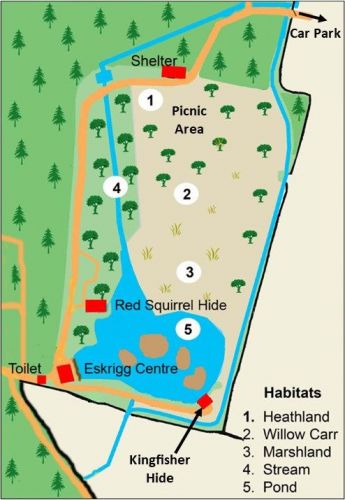
You can help look after the Reserve if you:
- keep to footpaths
- keep your dog on a lead while within the Nature Reserve
- clean up after your dog
- take your litter home
- respect all wildlife habitats, plants, animals and other visitors
- record any wildlife sightings at Eskrigg Centre
Location
The Reserve is located 1.6 miles (2.57 km) south-west of Lockerbie Town Centre, on the east side of South Turnmuir Plantation. (OS map ref. N.Y. 126805)

Getting to the Reserve from Lockerbie
Take the A709, Lockerbie to Dumfries road.
Just before leaving Lockerbie, turn left into Vallance Drive and then immediately right on to Eskrigg Farm Road.
Follow the farm road for 400m and the Reserve Car Park is on the right.
Please observe the 10mph speed limit.
Getting to the Reserve from Lochmaben or Dumfries
Take the A709 to Lockerbie.
As you enter the town, take the very first turning on the right into Vallance Drive and then immediately right on to Eskrigg Farm Road. Follow the farm road for 400m and the Reserve Car Park is on the right.
Please observe the 10mph speed limit.
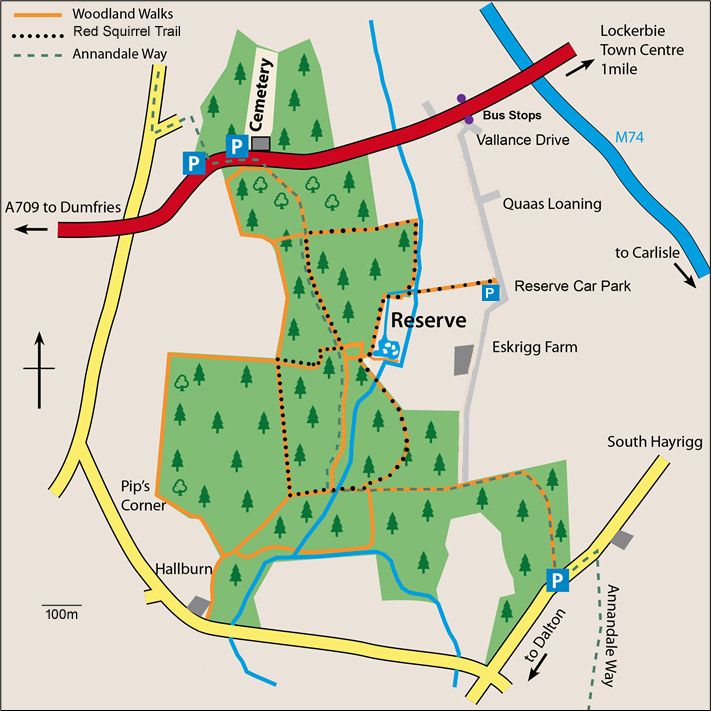
Reserve Car Park to Reserve
There is a hard-core, all-user path, leading 320m down a gentle slope from the Car Park to the Reserve. The path is fenced off from the fields on either side and is suitable for wheelchairs, mobility scooters, pushchairs and prams. There are 2 small gates near the beginning of the path that may need to be opened and closed when the farmer requires the fields on either side to be linked. When he doesn't, the gates will be open.
Access for those with mobility problems
It is possible, by prior arrangement with the Reserve Manager, to take a car or minibus down the forest road opposite the Dryfesdale Lodge Visitors' Centre to a small parking area within 100m of Eskrigg Centre. The single bar gate at the entrance to the forest road is normally kept locked and parking is not allowed in front of the gate. Access will not be possible when there are forest operations taking place in the woods.
A mobility scooter is available for use at Eskrigg Reserve by anyone with mobility problems. Please contact the Reserve Manager at least 24 hours before the scooter is needed so that it can be fully charged and delivered to the Reserve Car Park when required.
Access by Bus or on Foot
For those travelling by bus, there are bus stops on the Dumfries Road at the end of Vallance Drive. From the bus stop it is a ten-minute walk to the Car Park and another ten-minute walk from the Car Park to the Reserve. The Reserve is roughly forty-five minutes from Lockerbie Town Centre.
Map & leaflet of Reserve and Woodland Walks
Click on the pictures to view and download the map and leaflet (pdf)
You can help look after the Reserve if you:
- keep to footpaths
- keep your dog on a lead while within the Nature Reserve
- clean up after your dog
- take your litter home
- respect all wildlife habitats, plants, animals and other visitors
- record any wildlife sightings at Eskrigg Centre
Facilities
Car Park – There is space for up to 16 cars or other small vehicles – no coaches are allowed and there is no overnight parking. Coach parties need to make special arrangements with the Reserve Manager.
Path – A hardcore path runs from the car park down to and all through the reserve, with information / interpretation boards at regular intervals and offering views of most habitats. The path is continuous with a 3km hardcore trail allowing disabled access to the adjacent woodland.
Picnic Area – There are 5 picnic tables in a heathland area with a shelter nearby.
Red Squirrel Hide – A medium-sized, red squirrel / bird-watching hide with wheelchair access and views over the pond and wildlife feeding areas.
Eskrigg Centre – A large, high-quality hide / visitor centre with interpretation and teaching / research facilities and wheelchair access.
Kingfisher Hide – A small bird-watching hide (without wheelchair access) overlooking the pond.
Toilet – A compost toilet with disabled access.
Eskrigg Centre is open all year
beginning of March - end of October
from 8.00am - 5.00pm
beginning of November - end of February
from 9.00am - 4.00pm
other times by arrangement
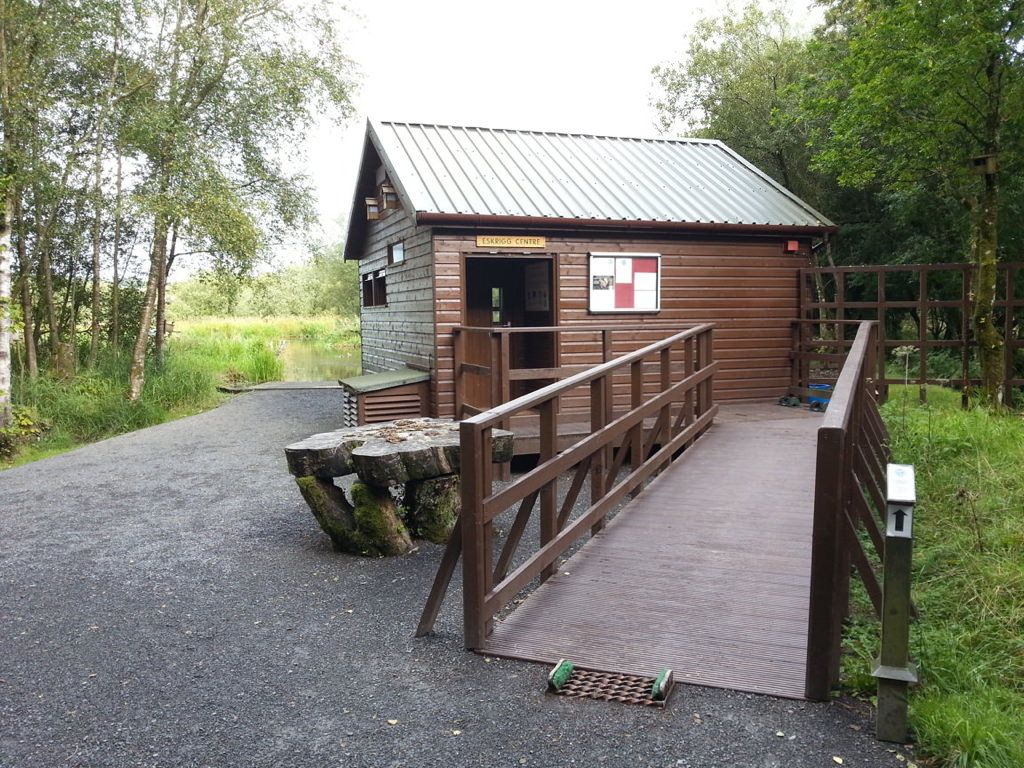
View of access ramp into Centre
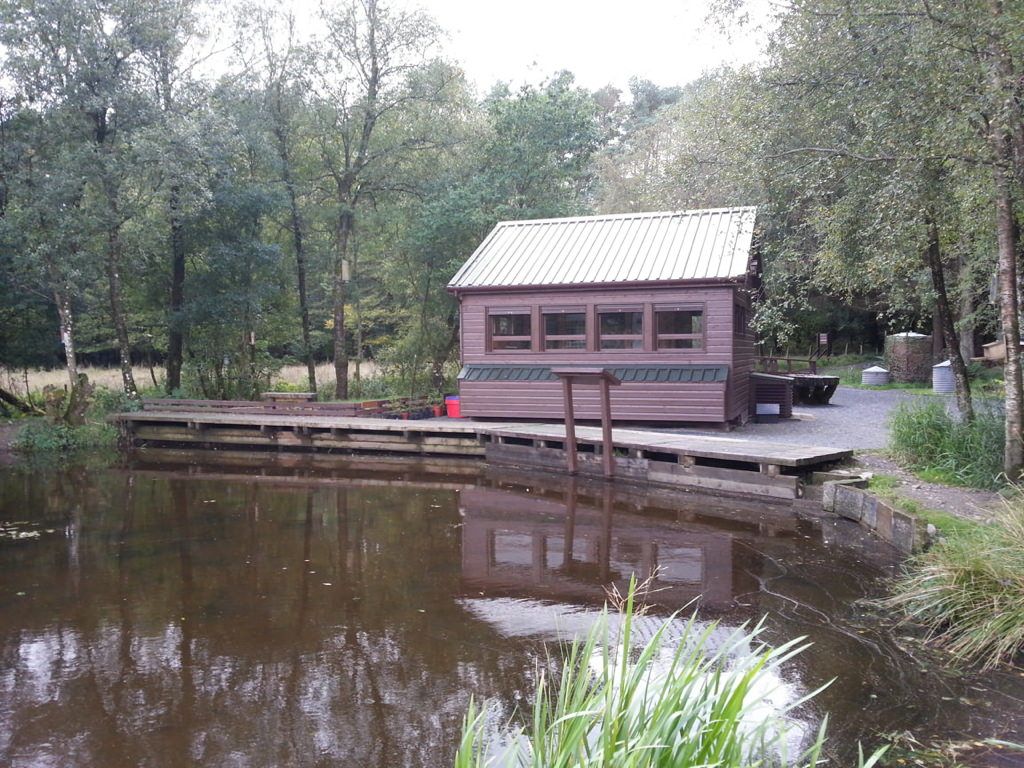
Front of Centre
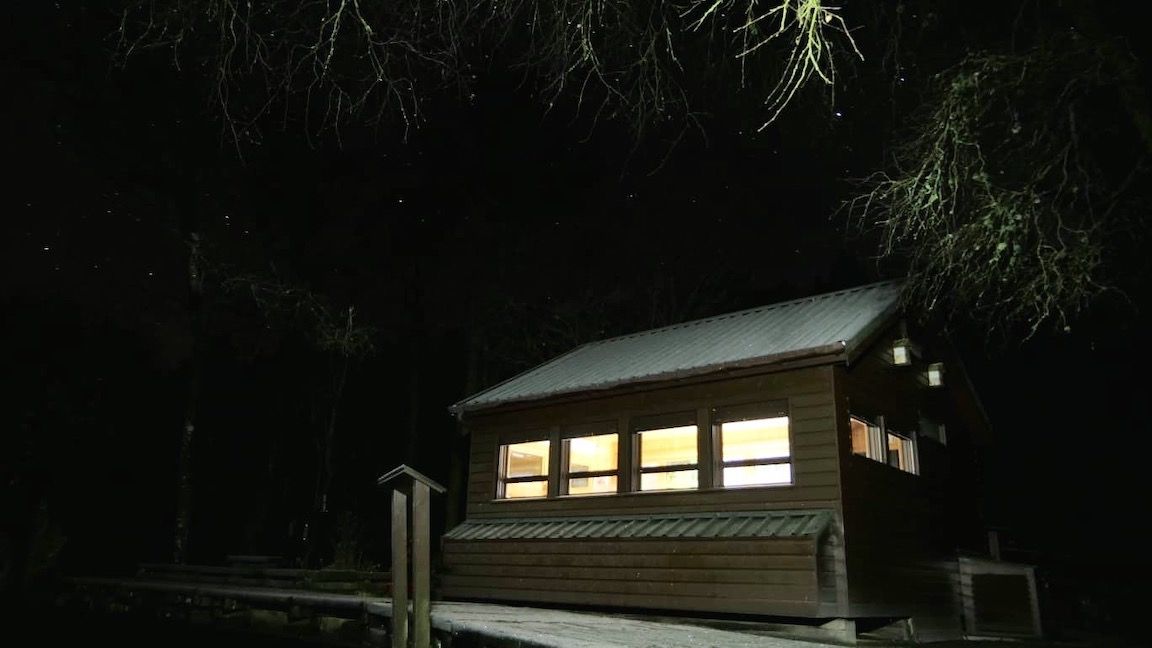
Front of Centre by night @ Billy Jardine
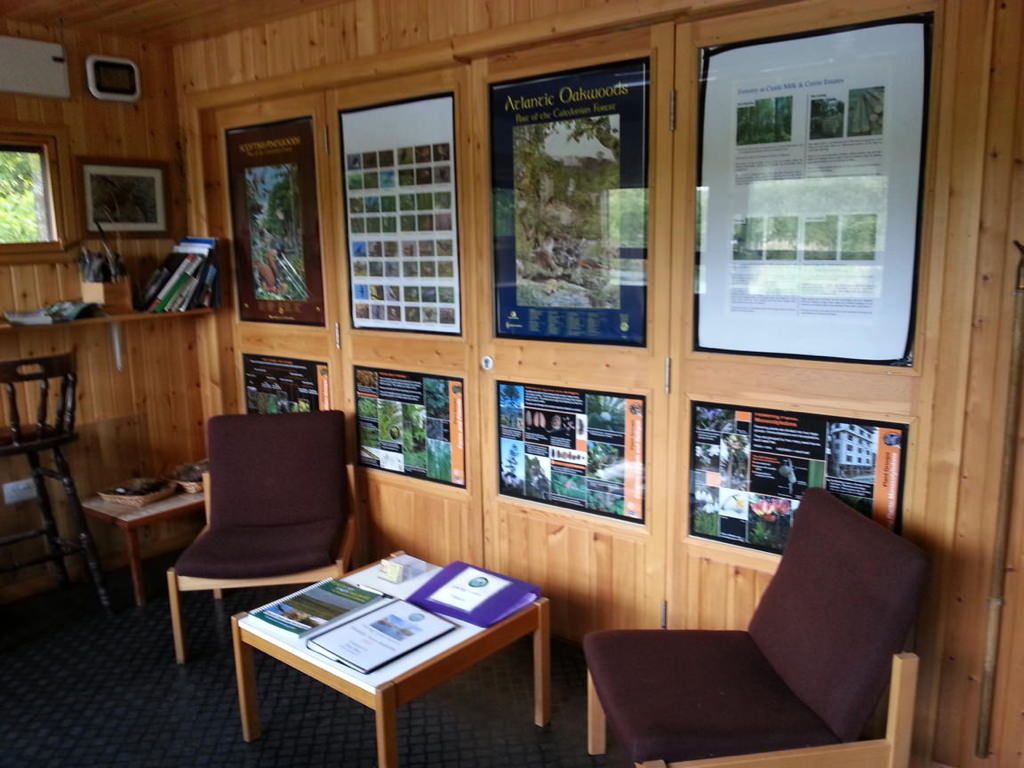
View of seating area inside Centre
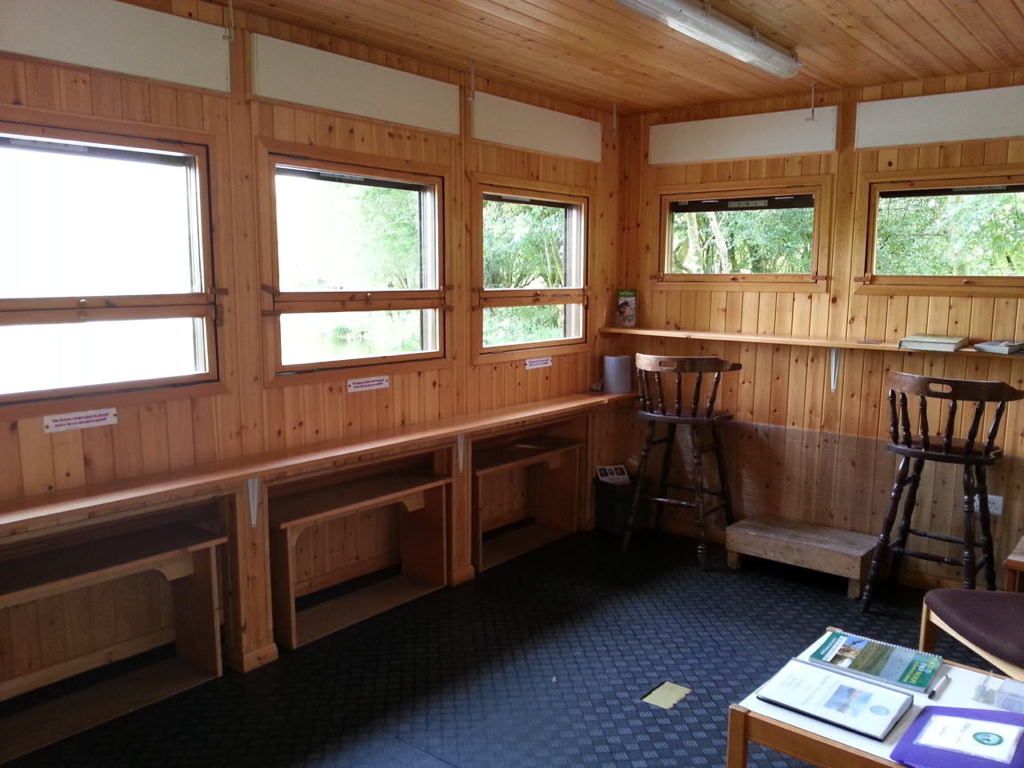
View of windows from inside
Red Squirrel Hide
The existing Red Squirrel Hide was erected in May 2013 and opened by Sir John Buchanan-Jardine, Bt. on the 19th.
The windows on the north side of the building face the bird and red squirrel feeding area, the window on the west side faces the pond.
The hide has double doors and a ramp to facilitate access by wheelchair or mobility scooter. All seating can be easily moved to accommodate either.
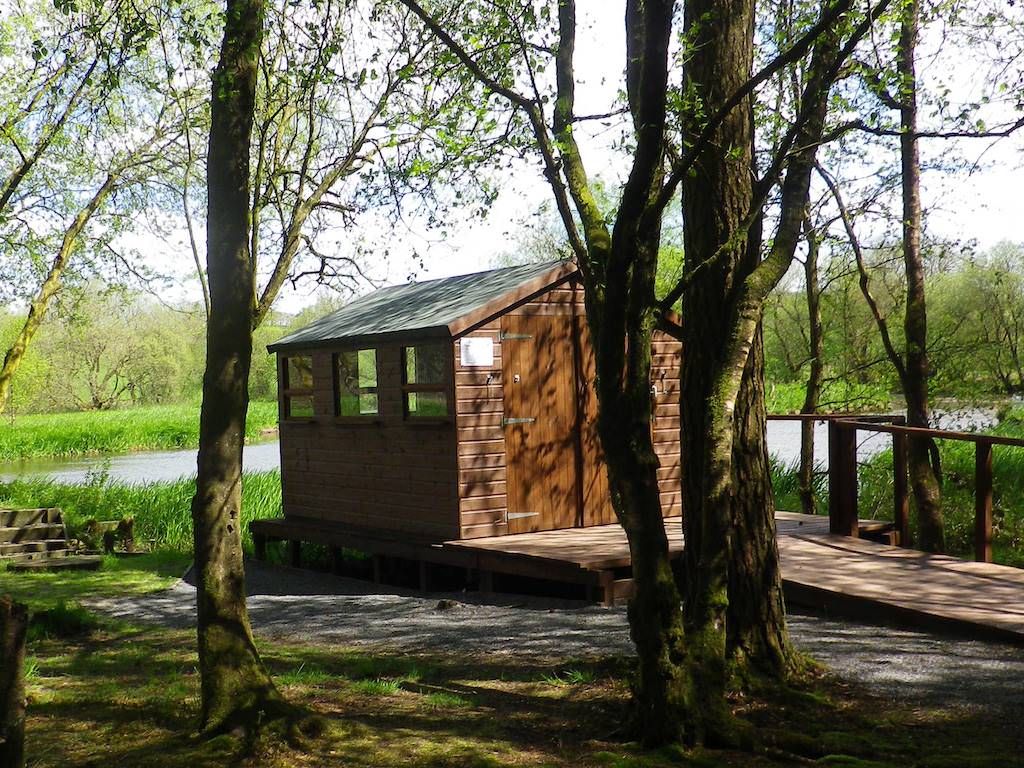
Red Squirrel Hide
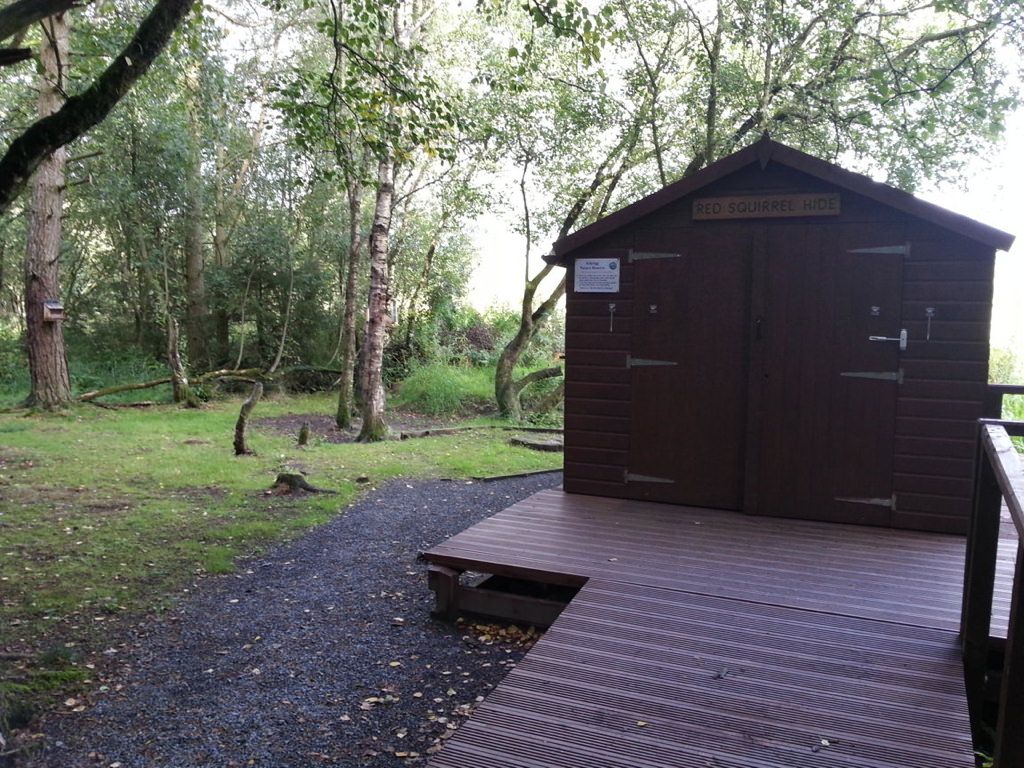
Entrance to Red Squirrel Hide
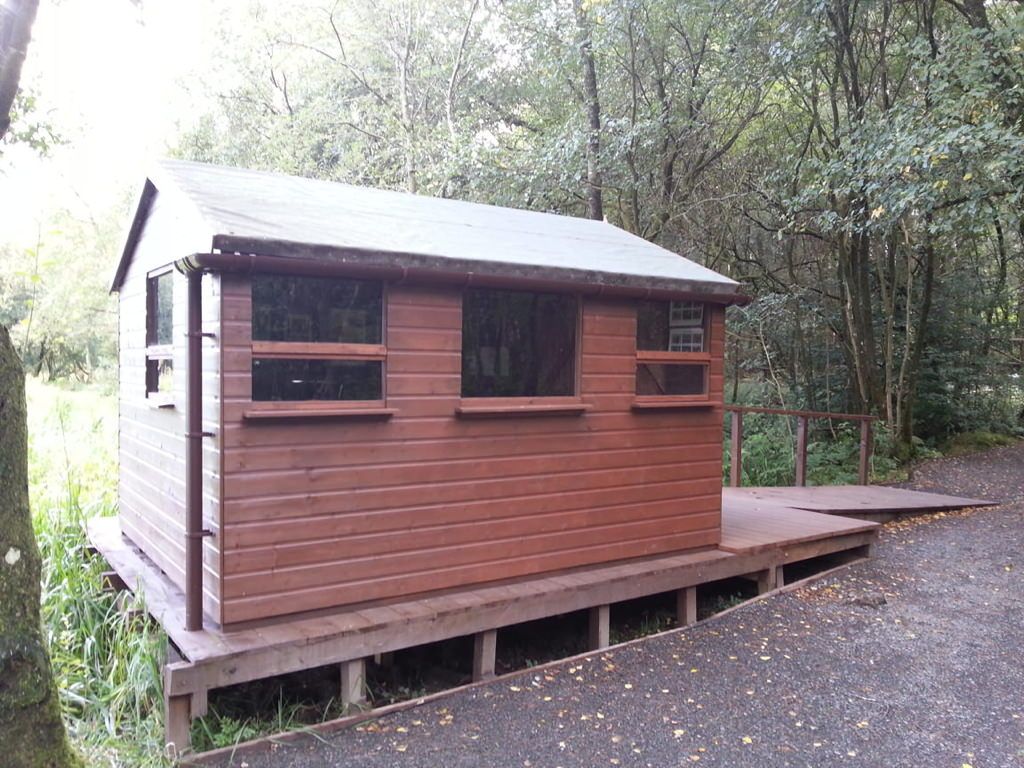
Front and side of Red Squirrel Hide
Kingfisher Hide
The cost of constructing the Kingfisher Hide was met by a generous donation of £5,000 by Joanne Burnett on behalf of her dear friend Mr Nigel Render who died 25th September 2016 aged 53.
The hide was prefabricated during 2020, by local joiner Scott McLean, and erected in September 2020 by Scott, assisted by his father, James and friend Chris Taylor. At that stage it had a temporary roof due to a shortage of the intended roofing material. The hide was completed in February 2021, when the local blacksmith, Alan Thomson, fitted the tin roof.
The Kingfisher Hide is situated in the south-east corner of the reserve, overlooking the pond and the resident wildfowl and with occasional sightings of the kingfisher, heron and otter.
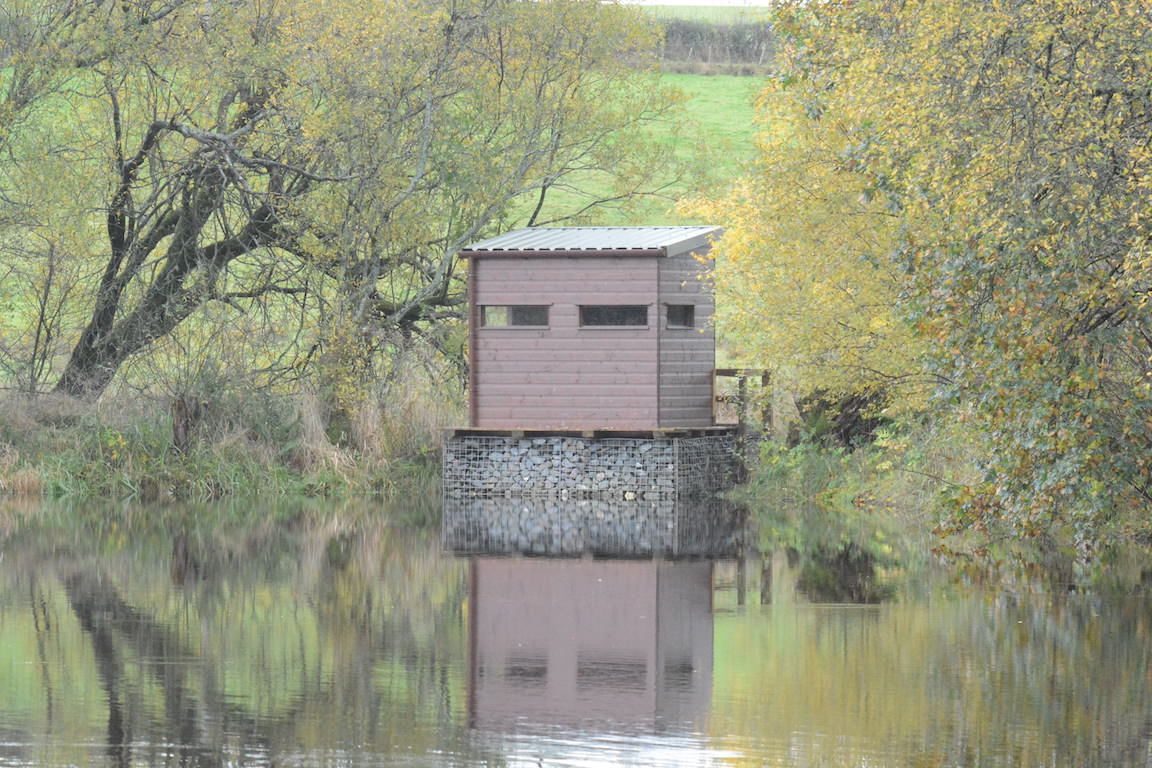
Kingfisher Hide - view from pond
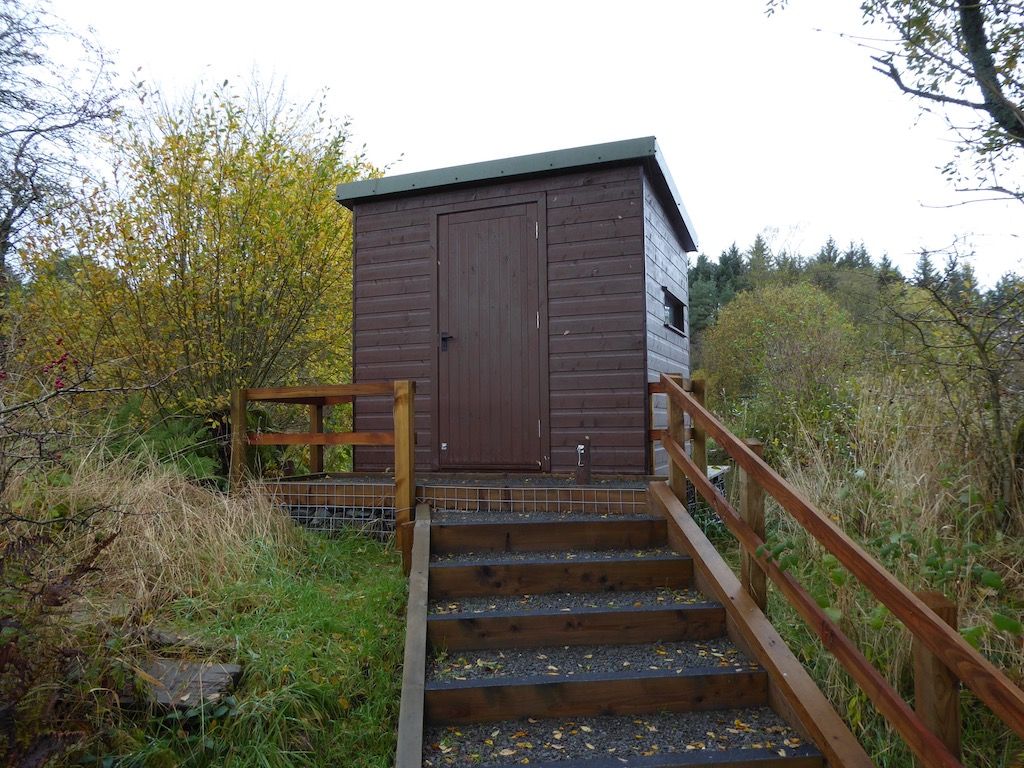
Kingfisher Hide - view from steps
Eskrigg Reserve Activities
Attendance at any of the Eskrigg Reserve activities is by prior booking only. To book you can send Jim an email or you can text or call him on 07739 987 009 .
There is no charge for any of the activities but donations to help with the running of Eskrigg Centre and the Reserve are always welcome.
Date
Activity
Time
Monthly Bulletins
Wildlife recorded at Eskrigg Reserve and Woodland Walks
All wildlife can be classified into groups that have features in common (see example of classification of British Insects). A group of living things that have so many common features that they can reproduce and have fertile young is called a species.
Most species at the Reserve can be put into the two major groups: PLANTS and ANIMALS. All the other organisms can be grouped under a third heading: the PROTISTS. Each of these groups can be sub-divided as follows:
Other Protists
- Protozoa (including Amoebae, Ciliates & Flagellates)
- Slime Moulds (including Cellular & Plasmodial forms)
- Algae (including unicellular, filamentous & colonial)
- Lichens (including rusty, leafy & shrubby forms)
Spore Producing
Seed Producing
on spore producing plants
on seed producing plants
Flowering Plants
Invertebrates
(without backbones)
Arthropods
(Hard outer skeleton
& jointed legs)
Insects
Other Arthropods
Other Invertebrates
Vertebrates
(with backbones)
Cold Blooded
- Amphibians (Breed in water, smooth, moist skin)
- Reptiles (Dry, scaly skin, lay eggs with soft shells)
Warm Blooded
The LWT Committee Members for 2025 / 2026
Chairman
Vice Chairman
Treasurer
Minute Secretary
Events Secretary
Membership Secretary
IT Coordinator
IT Support Officer
Reserve Manager
Assistant Education Officer
David Hughes
Sybille Spägele
Kathryn Hughes
Sybille Spägele.
Norah Muirhead
Jim Rae
Sybille Spägele
Gordon Reid
Jim Rae
Kaye Borthwick
Karen Miller
Annual Reports of the Lockerbie Wildlife Trust
Date of next AGM:
Wednesday 22nd October 2025
Trust Meetings
and Winter Talks Programme 2025 / 2026
These will be held in the
Lockerbie Town Hall, Community Rooms
at 7.30 pm
Entry is free for members, non-members will be charged £3.
AGM is free for all!
Date
Title of meeting / talk and speaker
Wed.
19 Nov.
"Reviving the Heart of Southern Scotland"
Adrian Kershaw - Borders Forest Trust
Wed.
17 Dec.
"Tarras Valley Nature Reserve:
The First Four Years''
Kat Mayer (Education & Engagement Officer)
Wed.
21 Jan.
"Solway Firth Partnership"
Nic Coombey
Wed.
18 Feb.
"Wild at Heart - A Photographer's Journey"
Gordon Rae
Wed.
18 Mar.
"Annan Harbour"
Alan Thomson & Olena Cadochnikova,
Annan Harbour Action Group
Fund Raisers 2024 / 2025
Date
Event
Location
© 1988 - | contact
